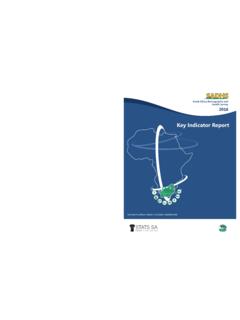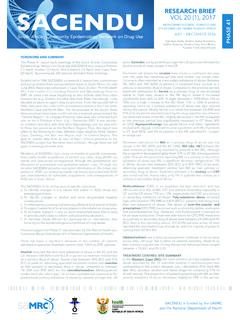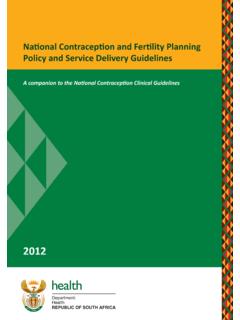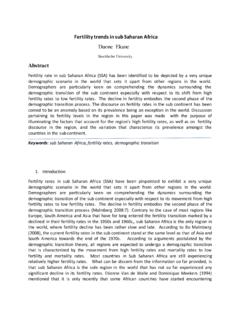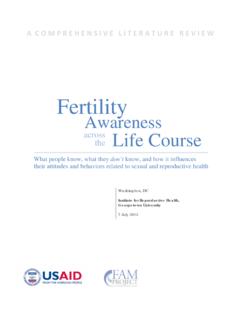Transcription of Trends in South African fertility between 1970 and 1998
1 Trends in South African fertility between 1970 and 1998 An analysis of the 1996 Census and the 1998 Demographic and Health Survey Technical Report Burden of Disease Research Unit Medical Research Council By Tom A. Moultrie Ian M. Tim us January 2002 Tom A. Moultrie Centre for Actuarial Research University of Cape Town Ian M. Tim us Centre for Population Studies London School of Hygiene & Tropical Medicine and Burden of Disease Research Unit Medical Research Council Contact Address: Dr Tom Moultrie Andrew W Mellon Foundation Postdoctoral Fellow in Demography Centre for Actuarial Research University of Cape Town Private Bag Rondebosch, South Africa Telephone: +27 (0)21 650 2475 Fax: +27 (0)21 689 7580 email: ISBN: 1-919809-17-1 Material from this report may be freely quoted, as long as full reference to source is given. ACKNOWLEDGEMENTS The authors thank the South African Department of Health for giving permission for the South African Demographic and Health Survey (DHS) to be analysed in this report.
2 We also thank Dr Debbie Bradshaw of the South African Medical Research Council (MRC) and Professor Rob Dorrington of the Centre for Actuarial Research at the University of Cape Town for advice and comments on this report, which was prepared as part of Tom Moultrie s doctoral research at the London School of Hygiene & Tropical Medicine, which was partly funded by the MRC. Gratitude is also expressed to Professors John Hobcraft and Ron Lesthaeghe for their insightful comments on the material presented in Section 4. I TABLE OF CONTENTS LIST OF LIST OF EXECUTIVE 1 2 DATA SOURCES AND Data 1996 South Africa 1998 South Africa 1970 South Africa A comparison of the data from the 1996 South Africa Census and the 1998 Analysis of background characteristics of African women aged Urban Province of fertility data in the 1996 Adjustment of lifetime fertility data in the 1996 South Africa Adjustment of current fertility data in the 1996 South Africa 3 CURRENT fertility , AND fertility DECLINE IN South AFRICA.
3 1970-1998 19 Estimates of lifetime fertility by population Estimates of current Age-specific fertility rates by population National age-specific fertility Provincial fertility estimates from the revised census data and the Trends in South African fertility 1955 All South African African Undercount of infants and children under 5 in the 1996 South Africa Cohort-period fertility rates for African 4 PARITY PROGRESSION AND BIRTH INTERVALS IN South Data requirements for the estimation of parity progression and birth Measures of parity Parity Progression Ratios (PPRs)..33 Projected parity progression ratios (Pi)..36 Truncated pairwise measures of parity progression (Bt)..38 The length of birth intervals among African South Adjusted measures of birth interval length trimeans and Projected median birth Univariate analyses of differentials in birth The proximate determinants of birth interval Preceding intervals as a determinant of birth interval Rural/urban differentials in birth interval Unadjusted mean and median birth 5 II APPENDICES TECHNICAL Appendix 1 The El-Badry Appendix 2 The correction in respect of Appendix 3 Corrections to the current fertility data in the Appendix Corrections arising from the El-Badry and stillbirth Appendix Correction for errors resulting from births in the last year being recorded as children ever Appendix Correction for women of parity one reporting one birth in the last Appendix Pro-rating of women reporting more than one birth in the year before the Appendix Use of Relational Gompertz
4 Appendix Analysis of the effects of the adjustments applied to the census Appendix Adjustment of the level of fertility using Feeney s Appendix 4 Calculation of fertility rates from the DHS Appendix 5 Weights used in the calculation of national age-specific fertility III LIST OF TABLES Tables in the Report Table Official estimates of total fertility in South Africa, Table Summary of estimates of total fertility in South Africa using data collected since Table Background characteristics of South African women aged Table Background characteristics of African South African women aged Table Proportions and numbers of African women aged 15-49 living in urban areas by age group .. 14 Table Percent distribution of African women aged 15-49 by age and completed level of 16 Table Mean children ever borne by women aged 15-49 by age and population Table Age-specific fertility rates for women aged 15-49 by population Table National age-specific fertility estimates, Census 1996 and DHS Table Estimates of age-specific fertility by province of usual residence, Census 1996 and DHS 24 Table Distributions by age of fertility used in the reverse-survival Table Percent undercount of African South African children (0-4) by sex, various Table Cohort-period fertility rates and P/F ratios, African women aged Table Parity progression ratios (PPR(i,i+1)) and cumulated parity progression ratios (PPR(0,i))
5 For African women aged 45-49, 1996 census, 1998 DHS and 1987-9 Table Parity progression ratios by age group, 1998 DHS and 1987-9 Table Truncated parity progression ratios by age group, 1998 DHS and 1987-9 Table Projected parity progression ratios for African women, 1998 DHS and 1987-9 Table Projected completed fertility of African women by cohort, 1998 Table Values of the quintum by parity, selected countries and African South African Table Values of the trimean, selected countries and African South African Table Median birth intervals (months) by age group and parity progression, 1998 DHS and 1987-9 DHS 45 Table Truncated median birth intervals (months) by age group and parity progression, 1998 DHS and 1987-9 Table Projected median birth intervals (months) using the truncation approach, 1998 Table Projected median birth intervals (months) using the truncation approach, 1987-9 Table Projected median birth intervals (months) using the truncation approach, urban and rural areas, 1998 DHS 54 Table Projected median birth intervals (months) using the truncation approach, urban and rural areas, 1987-9 Table Mean (closed) birth intervals in months for married African women in major metropolitan areas, by Table Median birth intervals (months)
6 For births in the five years prior to the survey, non-sterilised married and cohabiting women, 13 sub-Saharan African Tables in the Appendices Table A1 Summary statistics arising from the El-Badry correction, by population Table A2 Effect of the El-Badry adjustment on mean children ever borne, by population Table A3 Effect of the El-Badry adjustment on age-specific fertility rates, by population IV Table A4 Estimated number of stillbirths reported as live births in the census, and corrected estimates of mean children ever borne, African and Coloured Table A5 Age-specific fertility rates after correction for reporting stillbirths as live births, by population group 73 Table A6 Percent reduction in estimated age-specific fertility rates after correcting for reporting of children ever borne as births in the last year, by and population Table A7 Age-specific fertility rates after correcting for reporting of births in the last year as children ever borne, by population Table A8 Age-specific fertility rates after correcting for misreporting of recent births by older women of parity one, and after prorating births in the last year of more than one, by population Table A9 Age-specific fertility rates after application of the Relational Gompertz model, by population group 77 Table A10 Percent contribution to the reduction in estimated fertility of each of the adjustments to the census fertility data, by population Table A11 P/F ratios, by population Table A12 Mean of the fertility schedule and Feeney s scaling factor.
7 By population Table A13 Weights used in the estimation of national age-specific fertility rates from the 1996 Table A14 Weights used in the estimation of national age-specific fertility rates from the V LIST OF FIGURES Figures in the Report Figure Percent distribution of African women aged 15-49, according to age Figure Percent distribution of African women aged 15-49, according to age group and province of usual residence, 1998 DHS and 1996 Figure Mean living and mean dead children for all South African women, by age Figure Mean children ever borne, by age group and population Figure Percent distribution of fertility according to age by population Figure Trends in total fertility , all South African women, Figure Trends in total fertility , African South African women, Figure Cumulative fertility of African women 15-34, Figure Parity progression ratios (PPR(i,i+1)) for African women aged 45-49, 1996 census, 1998 DHS and 1987-9 Figure Indices of parity progression by birth cohort and parity for African women, 1998 DHS and 1987-9 Figure Proportion of women progressing to another birth within seven years.
8 1987-9 DHS and 1998 DHS 41 Figure Time location of births using projected median birth intervals, 1987-9 DHS and 1998 47 Figure Projected median birth intervals (months) of African women, by ever use of contraception prior to birth, 1998 DHS and 1987-9 Figure Projected median birth intervals of African women, by ever married status prior to birth, 1998 DHS and 1987-9 Figure Projected median birth intervals (months) of African women, by place of residence, 1998 DHS and 1987-9 Figures in the Appendices Figure A1 Extract from the South Africa DHS questionnaire, showing questions on Figure A2 Actual, and estimated, proportions of South African women reporting a single birth in the 12 months prior to the census, by parity and age VI FOREWORD Secondary analysis of survey and census data is important both to uncover new insights as well as to highlight where future data collection needs to be improved.
9 This study has served both these purposes well by combining the wealth of information from two major sources: the 1996 census and the 1998 Demographic and Health Survey. The description of the declining Trends is South African fertility has been deepened by this analysis to reveal that while the transition has followed a typical pattern observed in Africa with declines at all ages, this has occurred over an unusually long period and South Africa has experienced a unique phenomenon of very long intervals between births. This study reiterates the observation that the majority of women do not use contraception before the birth of their first child while contraceptive usage is high after the first birth. This has important policy implications, particularly in the context of the HIV epidemic. The authors recommend that family planning and reproductive health strategies need to focus on youth and make barrier methods acceptable to young people before they have their first child.
10 The detailed analysis and comparison of these data sets has identified some problems in the quality of the data. These need to be addressed in the future collection of such data, but also need to be taken into account when the results presented here are assessed. This study makes an important contribution to the growing knowledge base of South African demography and provides robust estimates for the current level of fertility that can be used for planning and policy development. Debbie Bradshaw Burden of Disease Research Unit VII EXECUTIVE SUMMARY The 1996 South Africa Census and the 1998 Demographic and Health Survey (DHS) provide the first widely available, comprehensive and nationally representative demographic data since 1970, and permit the analysis of aspects of South African demography that have never been investigated before. This report provides a detailed account of the South African fertility decline from 1970 to the present, and provides the most robust estimates of current levels of fertility in South Africa yet published using the 1996 census data.
